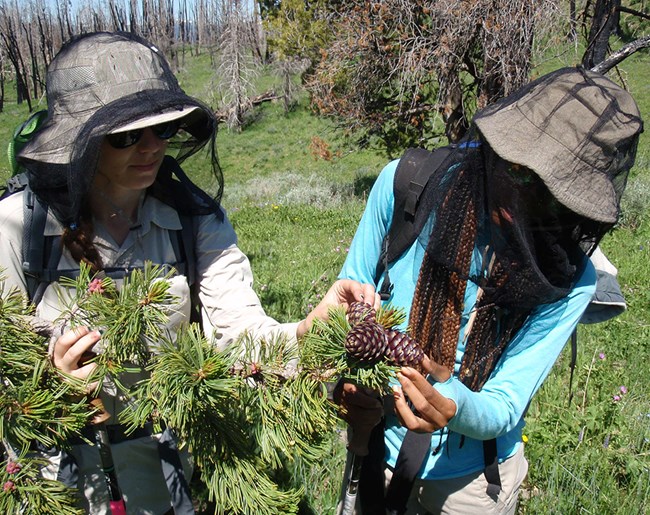US Fish and Wildlife Service lists whitebark pine as "Threatened" under the Endangered Species Act, January 17, 2023.

NPS Photo/Erin Shanahan
Whitebark pine (Pinus albicaulis) is a high-elevation tree of the northern Rocky Mountains and the Pacific Northwest. It grows in nearly homogeneous stands on harsh, dry terrain, but is more often found with other conifers in moister, more protected sites. This keystone species of subalpine slopes helps to reduce erosion and produces seeds (in its cones) that are a high-energy food source for birds and mammals. It often grows in places unfriendly to other trees and plants. Once established, however, it creates habitat favorable to other species, enabling forest succession to occur. Newly establishing plants, then, increase subalpine diversity.
Whitebark pine trees are on the decline as a result of several stressors. White pine blister rust, caused by the nonnative fungus, Cronartium ribicola, slowly damages and can eventually kill infected whitebark pine trees. Periodic outbreaks of native mountain pine beetle (Dendroctonus ponderosae), quickly decimate infested whitebark pine forests. Beetles preferentially attack larger, mature whitebark pine. The historical suppression of wildland fire has resulted in more frequent, bigger, and hotter wildfires. Finally, climate change exacerbates each of these stressors. Specifically, warmer temperatures enable mountain pine beetle to reproduce in one-year rather than multi-year cycles. Between 2007 and 2009, this shift resulted in a mountain pine beetle epidemic that killed 80% of the oldest trees in the ecosystem. Furthermore, scientists predict that increased drought due to warmer and drier conditions will boost wildfire frequency in the Greater Yellowstone Ecosystem. These agents act individually and together to impact whitebark pine populations throughout the West.
Since 2004, the Greater Yellowstone Network has been monitoring whitebark pine as part of a multiagency program. The Interagency Greater Yellowstone Ecosystem Whitebark Pine Monitoring Program tracks whitebark pine condition and trends on National Park Service, U.S. Forest Service, and Bureau of Land Management lands in the region. This monitoring addresses two overarching management concerns:
1. Is white pine blister rust increasing in the Greater Yellowstone Ecosystem?
2. Is the resulting mortality of whitebark pine sufficient to warrant consideration of management intervention, such as active protection and/or restoration?
To address these concerns, specific long-term monitoring objectives seek to answer the following questions.
We Ask:
-
What are the current rates and severity of white pine blister rust infection of whitebark pine?
-
Accounting for white pine blister rust infection, mountain pine beetle attack, wildland fire, and other agents of change, what is the survival rate of whitebark pine?
- What is the rate of recruitment of whitebark pine into cone-producing trees?
We Measure:
-
tree characteristics
-
diameter at breast height (dbh)
-
height
-
percentage of upper tree canopy volume that is alive
-
status: alive, recently dead, dead
-
-
recruitment
-
number of seedlings and saplings (all trees species in plots) in the understory
-
cone production
-
-
evidence of ecological effects
-
white pine blister rust infection:
-
presence of white pine blister rust cankers (infections) on the main trunk (bole) and in canopy branches
-
-
mountain pine beetle attack:
-
pitch tubes (popcorn-shaped resin masses outside the bark)
-
frass (boring dust in bark crevices or at base of tree)
-
J-shaped galleries (shallow tunnels under the bark for eggs and feeding)
-
-
fire scars
- other types of tree damage
-
View the protocol for monitoring this vital sign.
Publications
Source: NPS DataStore Collection 4076. To search for additional information, visit the NPS DataStore.
Source: NPS DataStore Collection 4060. To search for additional information, visit the NPS DataStore.
Source: NPS DataStore Collection 9295. To search for additional information, visit the NPS DataStore.
Source: NPS DataStore Collection 9179. To search for additional information, visit the NPS DataStore.
Whitebark Pine Monitoring Overview and Annual Results
Datasets
Source: NPS DataStore Collection 4061. To search for additional information, visit the NPS DataStore.
- Duration:
- 13.146 seconds
Mountain pine beetle hindered from entering a boring hole in this whitebark pine. The tree exudes sap - a pitch tube - to fend off attacking beetles.
Did you know...
In addition to whitebark pine, we monitor two other plant communities that serve as vital signs of park health: alpine vegetation and soils, and upland vegetation.
We also monitor climate, which is closely tied to whitebark pine health.
Last updated: June 12, 2025
